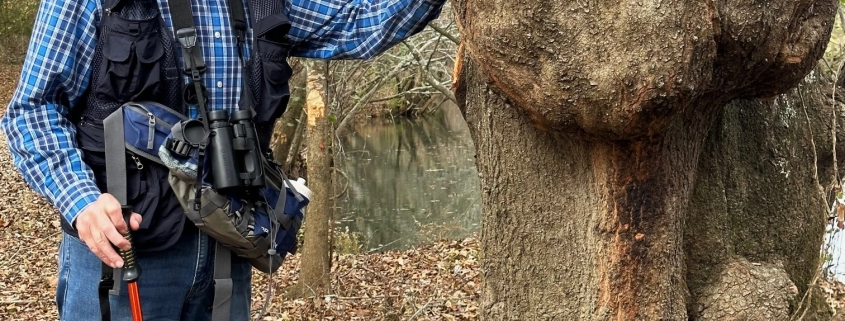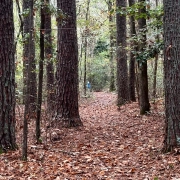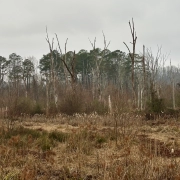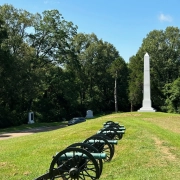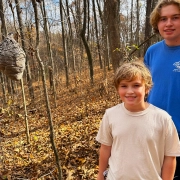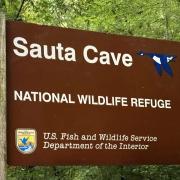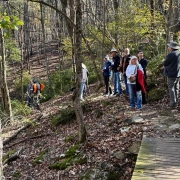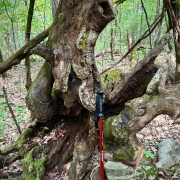Autumn Fungi, Dead Snags, and Trophy Oak Burl at Goldsmith-Schiffman Wildlife Sanctuary!
Left Knee Replacement Recovery Update
I’m adding this single-paragraph prolog on Leap-Day, February 29, 2024. I’m reaching back to content I gathered four months ago. You might ask, why the long lag period? During the autumn months, I was dealing with deteriorating knees, with total left knee replacement anticipated in mid-January, a date not yet confirmed. I was scheduled initially for June of 2023, but my unanticipated June 19, 2023, triple bypass delayed knee surgery. Knowing bad knees and then recovery would limit my woods-wandering for an extended period, I banked photographs, reflections, and observations for several months. Thus, now 37 days since knee surgery, I am writing this prolog, still uncertain when I can resume my woodland forays.
Mid-November Sanctuary Wandering
I visited Huntsville, Alabama’s Goldsmith-Schiffman Wildlife Sanctuary on November 14, 2023, with Dr. Marian Moore Lewis, author of Southern Sanctuary. We trekked through the western side of the Sanctuary, observing and reflecting upon all manner of seasonal life we encountered from Hidden Spring to Jobala Pond to the wetland mitigation project underway in the mid-property meadows and fields. I focus this Post on the autumn fungi, dead snags, and a trophy oak burl we encountered.
This Ganoderma lobatum is a hardwood decay fungus, one of 80 Ganaderma species. Its genus name means shiny or lustrous skin, apparent below left. Note the grass growing through the specimen below right.
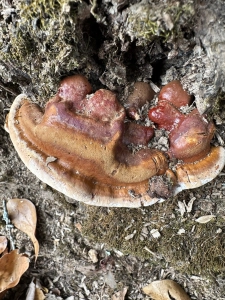
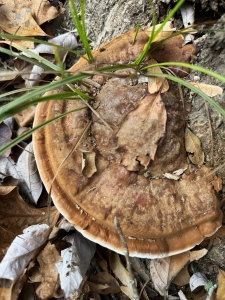
The mushroom (same species) below right is a prolific spore producer, coating surfaces near it with a thick beige dusting.
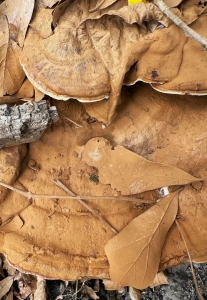
The oak below harbors oak bracket decay fungi. More than a foot across, the two fresh mushrooms have sprouted from one of the tree’s fluted trunk toes. The tree is living despite evidence of heavy infection. Like so much in Nature the decay infection and living tree are in a tenuous balance. The fungus consumes wood; the tree adds new wood. Eventually, gravity and other physical forces will prevail. That the tree will topple is inevitable. Decay is a crucial variable in the equation of life, death, and renewal.
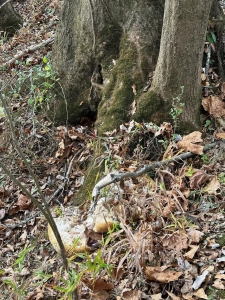
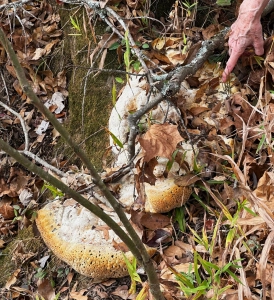
I recall plant (tree) pathology courses in undergraduate forestry studies. Educated from a timber management orientation, I viewed forest pathology and specific fungal agents as elements of the dark side, negatively affecting tree vigor and wood quality and value. Retired and long removed from that timber value orientation, I view fungi through an entirely different lens…an ecosystem perspective. I often find relevant wisdom in John Muir’s words:
When we contemplate the whole globe as one great dewdrop, striped and dotted with continents and islands, flying through space with other stars all singing and shining together as one, the whole universe appears as an infinite storm of beauty.
The oak bracket fungus is oblivious to the relative timber value of oaks. It knows only that its sole function is to achieve life-vigor sufficient to produce viable reproductive spores to ensure successive generations, its contribution to the health and viability of life within that one great dewdrop. Responsibility for managing the forest for timber production, income generation, wildlife habitat, water yield, or sundry other objectives rests with the forester. The disease agent (the fungus) is one of the factors in the forester’s zone of influence and control.
Another nearby large oak bracket mushroom is exuding resinous beads.
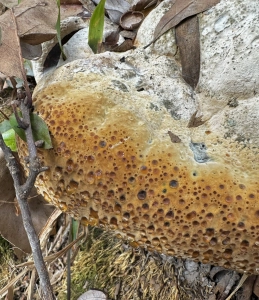
Marian has located yet another oak bracket, exposing its polyporus underside (below right)
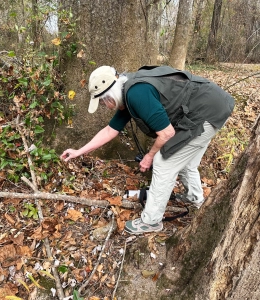
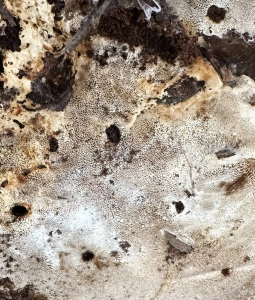
A nearby elm snag has seen its final summer. Decay fungi and marauding birds, squirrels, and other critters have weakened the snag. I can’t imagine the remnants resisting the pull of gravity through routine winter weather sure to bring soaking rains, strong winds, and maybe even snow and freezing rain.
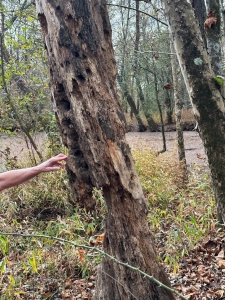
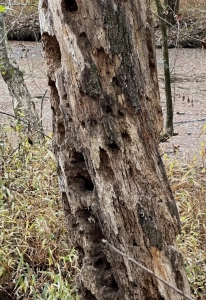
This willow snag stands within the upstream end of Jobala Pond, where the Hidden Spring wetland emerges into the pond.
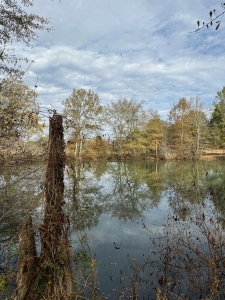
Fungi and snags go hand in hand, the snag is the final standing relic of decay fungi that likely began its decomposition decades earlier.
Trophy Water Oak Burl
Burls are not caused by decay organisms. I describe burls as benign tumors, triggered by some unknown biological agent (virus, bacterium, or fungus. Burls are often beautifully textured solid wood, treasured by wood-turning enthusiasts.
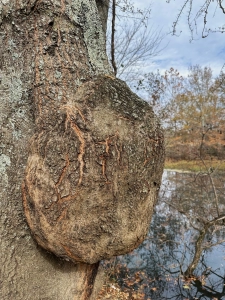
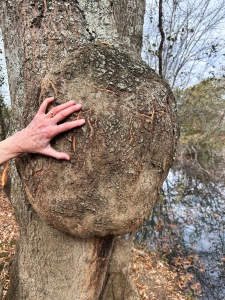
Because the oak grows at the Jobala Pond outlet, I visit it every time I enter the Sanctuary from the Taylor Road entrance.
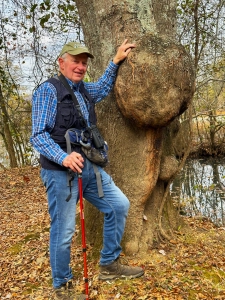
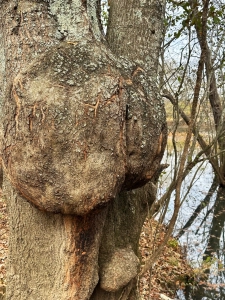
Its growth is quite evident. I snapped this image June 20, 2020. That’s then 12-year-old grandson Jack’s hand.
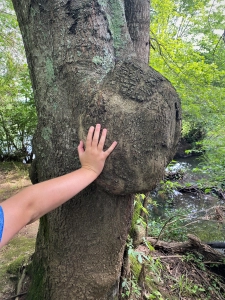
I try to visit the Sanctuary every 2-3 months, monitoring change and discovering what Nature reveals,
Thoughts and Reflections
I offer these observations:
- Nothing in Nature is static.
- When we contemplate the whole globe as one great dewdrop, striped and dotted with continents and islands, flying through space with other stars all singing and shining together as one, the whole universe appears as an infinite storm of beauty. (John Muir)
- Fungi and snags go hand in hand, the snag is the final standing relic of decay fungi that likely began its decomposition decades earlier.
Inhale and absorb Nature’s elixir. May Nature Inspire, Inform, and Reward you!
Note: Unless otherwise noted, all blog post images are created & photographed by Stephen B. Jones. Please circulate images with photo credit: “©2024 Steve Jones, Great Blue Heron LLC. All Rights Reserved.”
Another Note: If you came to this post via a Facebook posting or by another route, please sign up now (no cost… no obligation) to receive my Blog Post email alerts: http://eepurl.com/cKLJdL
And Third: I am available for Nature-Inspired Speaking, Writing, and Consulting — contact me at steve.jones.0524@gmail.com
A reminder of my Personal and Professional Purpose, Passion, and Cause
If only more of us viewed our precious environment through the filters I employ. If only my mission and vision could be multiplied by untold orders of magnitude:
Mission: Employ writing and speaking to educate, inspire, and enable readers and listeners to understand, appreciate, and enjoy Nature… and accept and practice Earth Stewardship.
Vision:
- People of all ages will pay greater attention to and engage more regularly with Nature… and will accept and practice informed and responsible Earth Stewardship.
- They will see their relationship to our natural world with new eyes… and understand their Earth home more clearly.
Tagline/Motto: Steve (Great Blue Heron) encourages and seeks a better tomorrow through Nature-Inspired Living!
Steve’s Three Books
I wrote my books Nature Based Leadership (2016), Nature-Inspired Learning and Leading (2017), and Weaned Seals and Snowy Summits: Stories of Passion for Place and Everyday Nature (2019; co-authored with Dr. Jennifer Wilhoit) to encourage all citizens to recognize and appreciate that every lesson for living, learning, serving, and leading is either written indelibly in or is powerfully inspired by Nature.
I began writing books and Posts for several reasons:
- I love hiking and exploring Nature
- I see images I want to (and do) capture with my trusty iPhone camera
- I enjoy explaining those images — an educator at heart
- I don’t play golf!
- I do love writing — it’s the hobby I never needed when my career consumed me
- Judy suggested my writing is in large measure my legacy to our two kids, our five grandkids, and all the unborn generations beyond
- And finally, perhaps my books and Blogs could reach beyond family and touch a few other lives… sow some seeds for the future
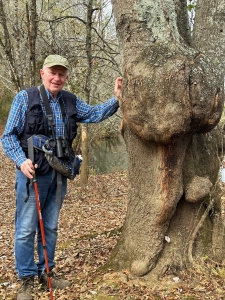
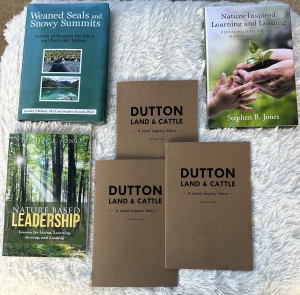
All three of my books (Nature Based Leadership; Nature-Inspired Learning and Leading; Weaned Seals and Snowy Summits) present compilations of personal experiences expressing my (and co-author Dr. Wilhoit for Weaned Seals and Snowy Summits) deep passion for Nature. All three books offer observations and reflections on my relationship with the natural world… and the broader implications for society. Order any from your local indie bookstore, or find them on IndieBound or other online sources such as Amazon and LifeRich.
I now have a fourth book, published by Dutton Land and Cattle Company, Dutton Land & Cattle: A Land Legacy Story. Available for purchase directly from me. Watch for details in a future Post.

